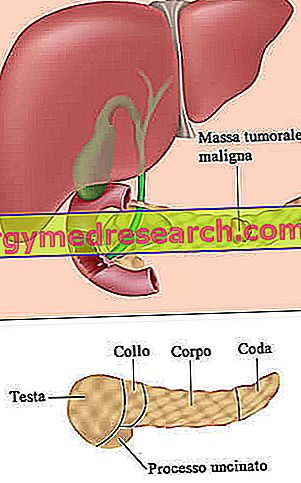Generality
An adenocarcinoma is a carcinoma - therefore a malignant tumor - which originates specifically from the cells of the glandular epithelium, present in the exocrine glandular organs (for example pancreas, breast or prostate) and in general in tissues with secretory properties (for example mucous lining of the esophagus, stomach or colon).

The biopsy test (or biopsy) is essential to diagnose adenocarcinoma. From the biopsy, doctors are able to learn about staging and the degree of malignant cancer.
Short review of what a carcinoma is
A carcinoma is any malignant tumor (or malign neoplasm) originating from an epithelial-type cell.
Epithelial tissues constituting epithelial type cells are the cellular elements that cover the surfaces of all the external and internal structures of the human body, including cavities and glands.
Carcinomas possess a high infiltrating power - that is, they invade neighboring tissues with ease - and a marked metastasizing capacity - ie they are able to disseminate tumor cells ( metastases ) in organs distant from the site of origin of the neoplasm.
In general, the classification of carcinomas depends on the type of epithelial cell from which the proliferation of the neoplastic mass begins.
What is an adenocarcinoma
An adenocarcinoma is a type of carcinoma - hence a malignant tumor - that originates from epithelial cells of the exocrine glandular organs or from epithelial cells of tissues with secretory properties.
Examples of exocrine glandular organs are breast, pancreas or prostate; examples of tissues with secretory properties, on the other hand, are the layers of mucosa that line the inner wall of the esophagus, stomach, colon or rectum.
WHAT IS NOT?
The doctors exclude from the list of adenocarcinomas all the tumors of the endocrine glands, which are called neuroendocrine tumors .
Examples of neuroendocrine tumors are: the VIPoma, insulinoma or pheochromocytoma.
ORIGIN OF THE NAME
The term adenocarcinoma derives from the union of two words:
- "Adeno" which, in the medical field, refers to the glandular system.
- "Carcinoma" which means "ulcer" or "sore". Carcinoma is a word of Greek origin; it derives from "karkinoma" ( καρκίνωμα ), which in turn comes from "karkinos", meaning "crab".
BENIGNO EQUIVALENT
The benign equivalent of adenocarcinoma is adenoma .
Sometimes, adenomas can turn into adenocarcinomas: this is the case, for example, of colorectal carcinomas that derive from adenomas of the colon.
Causes
The human body contains just over 37 trillion cells . These cells have a life cycle, which involves phases of growth, division and death. The entire life cycle of a generic cell in the human body depends on its genetic heritage, contained in the cellular nucleus and known as DNA . DNA is a highly efficient and precise machine, capable of accurately directing and controlling the phases of growth, division and death.
An adenocarcinoma (and in the same way a generic carcinoma) arises as a result of irreparable damage to the DNA ( mutation ), damage that prevents the DNA itself from accurately and accurately regulating the cellular processes of growth, division and death.
It follows that the cell or cells involved in the mutation of the genetic heritage grow and divide uncontrollably (there is also talk of uncontrolled cell proliferation ).
The cells of a carcinoma - but in reality all the cells of a malign neoplasm - also take the name of " cells gone mad ": this wording indicates precisely the anomaly that distinguishes them and the characteristic lack of control in the processes of growth and division.
A FEW DETAILS IN MORE THAN MUTATIONAL PROCESSES
To cause any adenocarcinoma - as well as another malignant tumor - it is never a single DNA mutation, but a series of mutations .
Generally, the mutations that cause an adenocarcinoma, in a human being, appear at different times in life; in other words, the uncontrolled cellular proliferation, typical of adenocarcinomas, is the result of a slow accumulation of mutations, during the aging process.
The slow accumulation of mutations in the course of life, by those who develop a carcinoma, explains why patients are usually elderly people. Young people with a carcinoma are particularly unlucky individuals, because, for them, the accumulation of mutations has been very rapid.
Curiosity: DNA has a defense system that corrects mutations
Among the various activities of human DNA, there is also that of generating proteins responsible for correcting the mutations that, in the course of life, affect the DNA itself. In other words, our genetic heritage has a system of self-defense against mutations.
This self-defense system is very effective; however, in some cases, it fails or makes mistakes and this involves the permanence of one or more mutations against the DNA.
Mistakes are usually made by the defense system against mutations that lay the foundations for the development of malignant neoplasms.
Types
The best known human adenocarcinomas are:
- Colorectal adenocarcinoma
- Adenocarcinoma of the lung
- Adenocarcinoma of the breast
- Pancreatic adenocarcinoma
- The adenocarcinoma of the esophagus . It is the most common form of malignant tumor of the esophagus.
- Adenocarcinoma of the uterine cervix . Typically, malignant tumors of the uterine cervix are squamous cell carcinomas (ie carcinomas that originate from squamous cells). However, in 10-15% of cases, they are adenocarcinomas.
- Adenocarcinoma of the prostate . Almost all (99%) of malignant prostate tumors are adenocarcinomas.
- Papillary adenocarcinoma of the thyroid . Represents between 75 and 85% of thyroid malignant tumors.
- Adenocarcinoma of the stomach or gastric adenocarcinoma . Represents about 90% of malignant tumors of the stomach. It is particularly common in Japan, China, South America and Eastern Europe.
- Adenocarcinoma of vulva and vagina
- The cholangiocarcinoma . It is an adenocarcinoma that originates from the epithelial cells constituting the bile ducts.
- Adenocarcinoma of urachus . The uraco is a tract of the urinary tract of the fetus, which connects the bladder to the umbilical cord. A few months after birth, it obliterates and becomes a fibrous cord.
About 80% of malignant tumors of the urachus are adenocarcinomas.
ADENOCARCINOMA OF THE BREAST
Adenocarcinoma of the breast is the main form of breast cancer .
In general, the epithelial cells from which it originates are those that constitute the so-called ducts or so-called breast lobules .
From a histological point of view, doctors classify adenocarcinoma of the breast into three subtypes:
- Invasive ductal carcinoma : accounts for 55% of breast cancers.
- Ductal carcinoma in situ : represents 13% of breast cancers. Carcinomas defined as " in situ " are pre-cancerous tumors, which possess some characteristics of a real carcinoma, but, compared to the latter, they do not yet have the same infiltrating power and the same metastasizing capacities.
- Invasive lobular carcinoma : represents 5% of breast cancers.
COLON-RECTENED ADENOCARCINOMA
Colorectal adenocarcinoma represents one of the main forms of malignant tumor of the colorectal tract of the intestine.
The tumor mass that constitutes it originates from a cell of the intestinal mucosa (obviously of the colo-rectal tract).
As we said, many adenocarcinomas of the colon-rectum are the result of a malignant evolution of adenomas, ie benign tumors originating from exocrine glands or with secretory properties.
LUNG ADENOCARCINOMA
Lung adenocarcinoma represents the most important malignant form of lung cancer (almost 80% of cases).
The precise place of origin of pulmonary adenocarcinomas is at the level of peripheral epithelial tissues of the lung ; these tissues include the cells of the bronchial tree (terminal tract) secreting mucus and the cells of the pulmonary acini.
In most cases (but not always!), Patients with lung adenocarcinoma are smokers, so there is a clear correlation between tobacco smoking and the risk of developing the aforementioned malignant tumor.
There are various subtypes of adenocarcinoma of the lung, including bronchioalveolar carcinoma and bronchial carcinoid .
Note: the malignant tumors of the lungs other than adenocarcinoma are small cell carcinoma, large cell carcinoma and squamous cell carcinoma.
ADENOCARCINOMA DEL PANCREAS
Adenocarcinoma of the pancreas, or exocrine tumor of the pancreas, usually originates from the epithelial cells of so-called pancreatic ducts. It is a very aggressive neoplasm, often with dramatic results.
According to some statistics, in Italy, every year, adenocarcinoma of the pancreas would affect about 10, 000 people.
Symptoms
For obvious reasons, the symptoms of an adenocarcinoma depend on the site of the neoplasm.
To know more:
- Lung cancer symptoms
- Pancreatic tumor symptoms
- Symptoms of breast cancer
- Colorectal cancer symptoms
- Symptoms of prostate cancer
- Symptoms of esophageal cancer
Diagnosis
For a diagnosis of accurate adenocarcinoma and including information on its severity, biopsy is essential.
In fact, doctors are able to study in detail the cellular and molecular characteristics of the malignant epithelial tissue, forming the tumor mass.
In describing an adenocarcinoma (as well as any other malignant tumor), two parameters, known as staging and grade, are fundamental.
STAGING
The staging of a malignant tumor (therefore also of an adenocarcinoma) includes all that information, collected during biopsy, which concerns the size of the neoplasm, its infiltrating power and its metastasizing capacities.
By convention, doctors have established that there are 4 different levels of staging, identified with Roman numerals I to IV. From the least severe to the most severe, these staging levels are:
- Stage I : all stage adenocarcinomas are less than 2 centimeters in size I and are limited to the formation zone (therefore they have not invaded any neighboring anatomical structure).
In general, a stage I adenocarcinoma has good treatment possibilities: both surgical excision and chemotherapy and radiotherapy are very effective.
To complicate the therapy may be the presence of a tumor mass located in a particularly uncomfortable site to reach, through medical-surgical instruments.
- Stage II : all adenocarcinomas of sizes between 2 and 5 centimeters fall within stage II and are still limited to the area of origin.
In general, a stage II adenocarcinoma is treatable with more than fair results.
As in the previous case, a tumor mass formed at a particularly inconvenient point to reach with medical-surgical instruments can complicate the treatment.
- Stage III : all adenocarcinomas larger than 5 centimeters and which have invaded, with their malignant cells, the regional lymph nodes (ie those adjacent to the onset area) and some adjacent anatomical structures are included in stage III.
The chances of treatment of a stage III adenocarcinoma are much lower than in the two previous cases (stage I and stage II). Treatment difficulties are related to the dispersion of malignant cells in the midst of healthy cells from the surrounding tissues and the need to also remove "contaminated" lymph nodes.
- Stage IV : all the adenocarcinomas which, regardless of size, have invaded the anatomical tissues adjacent to the area of origin of the neoplasm and disseminated metastasis around the body belong to stage IV.
The possibilities of treatment for a stage IV adenocarcinoma are very small. In fact, the removal of the tumor mass is remarkably complex and unsuccessful, as is the treatment of metastases.
It is good to inform readers that, in reality, the framework of staging is somewhat more complex than that presented above. In fact, it would also include a series of sub - stages and a classification of metastases, linked to their presence / absence or to their proximity / distance.
ABLE
The degree of a malignant tumor, including adenocarcinoma, includes all those data that emerged during the biopsy exam, which concern the extent of transformation of malignant tumor cells, compared to their healthy counterparts. In other words, it is an index of how much tumorigenesis (ie the formation of the neoplasm) has affected the morphology of the epithelial cells involved, modifying its original appearance.
By convention, doctors have decreed that there are 4 different degrees of increasing gravity, identified with the Arabic numbers from 1 to 4:
- Grade 1 : Grade 1 is an adenocarcinoma whose malignant cells still bear a strong resemblance to their healthy counterparts. This strong similarity leaves little doubt about the type of epithelial cell from which the neoplasm originated.
Belonging to the category of well-differentiated carcinomas, grade 1 adenocarcinomas are the least severe and most easily treatable forms of adenocarcinoma.
- Grade 2 : grade 2 is an adenocarcinoma whose malignant cells, although they still have a certain similarity with healthy counterparts, have clear tumor characteristics, such as irregularity in shape and cellular multi-stratification (at least 7 layers of overlapping cells) .
Belonging to the category of moderately differentiated carcinomas, grade 2 adenocarcinomas are forms of adenocarcinoma of medium-low severity and good chances of treatment.
- Grade 3 : grade 3 is an adenocarcinoma that has malignant cells that do not resemble healthy counterparts, with a very irregular appearance, arranged in more than 10 superimposed layers and with a good capacity for mitosis (mitosis = cell division).
Belonging to the category of poorly differentiated carcinomas, grade 3 adenocarcinomas are forms of adenocarcinoma of medium-high severity and reduced chances of treatment.
- Grade 4 : Grade 4 is an adenocarcinoma that has malignant cells that are totally different from healthy counterparts (they are unrecognizable), very irregular in shape and with a high capacity for mitosis (ie they divide with high frequency).
Belonging to the category of undifferentiated carcinomas, grade 4 adenocarcinomas are the most serious forms of adenocarcinoma and have limited possibilities for treatment.
OTHER IMPORTANT DIAGNOSTIC PROCEDURES
Useful both for the identification of an adenocarcinoma and for its description are also the two diagnostic tests known as TAC (or Computerized Axial Tomography) and nuclear magnetic resonance (NMR).
CT scan is an exam that uses X-rays to create three-dimensional images of an anatomical section. Doctors also exploit it during the treatment of an adenocarcinoma, in order to evaluate the therapeutic effects of ongoing treatments.
NMR, on the other hand, is a procedure that provides images of internal organs and tissues, through an instrument capable of creating radiofrequency magnetic fields.
Prognosis
Generally, the prognosis of an adenocarcinoma depends on its staging and its degree.



